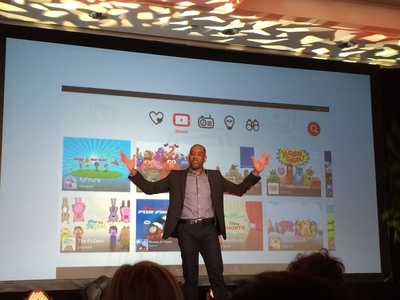It's an organizer's dream to kick off a conference with a wave-making keynote that ripples throughout the event. Kidscreen 2015 certainly got that with Malik Ducard's introduction of the YouTube Kids app.
Though the news had broken the week before (and been speculated about for months), Ducard's walkthrough of the rationale and function of the app added detail and insight. Debate over the impact of YouTube Kids became a conversation starter throughout the Summit among content creators and distributors alike.
Kids already spend lots of time with YouTube, and it's become not only a top entertainment destination, but a key contributor to their learning. Increasingly, young people look for visual demonstrations to answer questions (think Khan Academy's math solutions, for example) or pursue intrinsic interests like Minecraft. Ducard told the audience that educational titles now get twice as many clicks as animal videos.
Some people's reaction to the app was, "isn't YouTube 'YouTube Kids'"? After all, Ducard also noted that while overall viewing time was up 50 percent over the past year, time spent watching family videos was up 200 percent.
The problem? In today's overcrowded marketplace of children's content, trust is a most valuable currency, and many parents worried that YouTube's recommendation engine could lead from race cars to racy in just a click or two. This was equally a problem for kid IP owners who didn't want their safe content to show up next to something inappropriate.
Any individual Kidscreen delegate's feelings coming out of the opening keynote depended substantially on their role and function going in. Content partners for YouTube Kids -- Sesame Workshop, HIT Entertainment, Reading Rainbow, for example -- had to be thrilled. Kid-friendly content creators had to be encouraged about a new potential outlet, even though the presentation was light on details about how videos would be solicited, selected or vetted.
Outside reviewers were of mixed opinion. Children's Technology Review gave the app a 98 percent, A+ review, but Venture Beat gave it thumbs down for exposing kids to advertising.
This will be critical in YouTube Kids' acceptance -- would parents rather pay for video by subscription or by accepting advertising? Google addressed many other parental peeves -- content is carefully vetted and search terms controlled, and the app has built-in capacity to set time limits, but for some parents, commercialism trumps all.
Still, I've yet to see anyone propose any viable, ethical financial model for content aside from direct payment, freemium or advertising (but they do want quality content).
Two groups in the room had to be anxious: traditional or linear telecasters and those behind the burgeoning array of other VOD platforms.
For children's channels, YouTube Kids represents competition for content and viewers (in a year when traditional TV audiences are down four percent and streaming audiences up 60 percent). Moreover, it's bound to fragment further an already unsettled ad market, by providing marketers with a "safer" digital option, as mobile becomes young people's primary screen and brands chase audiences.
Kid video on-demand services have been popping up almost weekly. Some are by subscription, some have advertising, and others offer shows for purchase. Some are from the biggest companies (Viacom reviving the Noggin brand for preschool streamed content) and some from startups. All saw their world and business model tilted on its axis with the YouTube Kids launch. As the CEO for Magicflix told me, Ducard's keynote was the speech they've been giving to their investors, to parents and to program suppliers, promising an "educational and safe" option for children.
The way I see it, there are three types of VOD business that are relatively protected from the YouTube tsunami:
- The most massive services -- particularly those that have content for all audiences, like Amazon, Netflix or Hulu -- will be minimally affected, though they may see more competition for acquisition or development (YouTube Kids said very little about how it would pursue new and original content);
Of course, no one -- not these three groups or even YouTube Kids -- is immune from the biggest challenges to children's TV. There's a glut of content, and parents are overwhelmed (kids may be less so, if only because most have never known a world without mobile media). Curation, review and navigation services are bound to gain increasing power -- see my above comments about trust. Subscription fatigue has to be a worry -- how many can a typical family support?
There's also the basic issue of defining what is "television." One Kidscreen Summit panel considered the statement, "if your mission is to save television, you've already lost." I'd contend that the goal isn't to "save" TV, but to redefine it. Young people already have: for them, it's not the box in the corner, or even 22-minute stories around a brand. Instead, it's video in all its glorious forms -- six-second Vines, watching others play games on Twitch, UGC and Spongebob.
Some at Kidscreen asked whether kids' tastes have suddenly changed to prefer short-form content. I'd contend that the causal relationship is the other way around: young people finally have platforms designed to offer something they've wanted and never gotten.
If anything, the biggest issue -- another that will affect every service big and small -- is that kids are watching "TV" on mobile devices where one touch of the home button doesn't just take them to another channel, but to games, apps, social media and the limitless Internet. The competition isn't other TV; it's everything.
No matter what, the situation is what Kidscreen speaker Randi Zuckerberg called "Dot Com-plicated." I've always enjoyed being neither a buyer nor a seller at Kidscreen, able to sit back, listen and watch the dance. That was never so true as in 2015, when the market shifted so radically.
This article appeared originally in Kidscreen on February 26, 2015.
